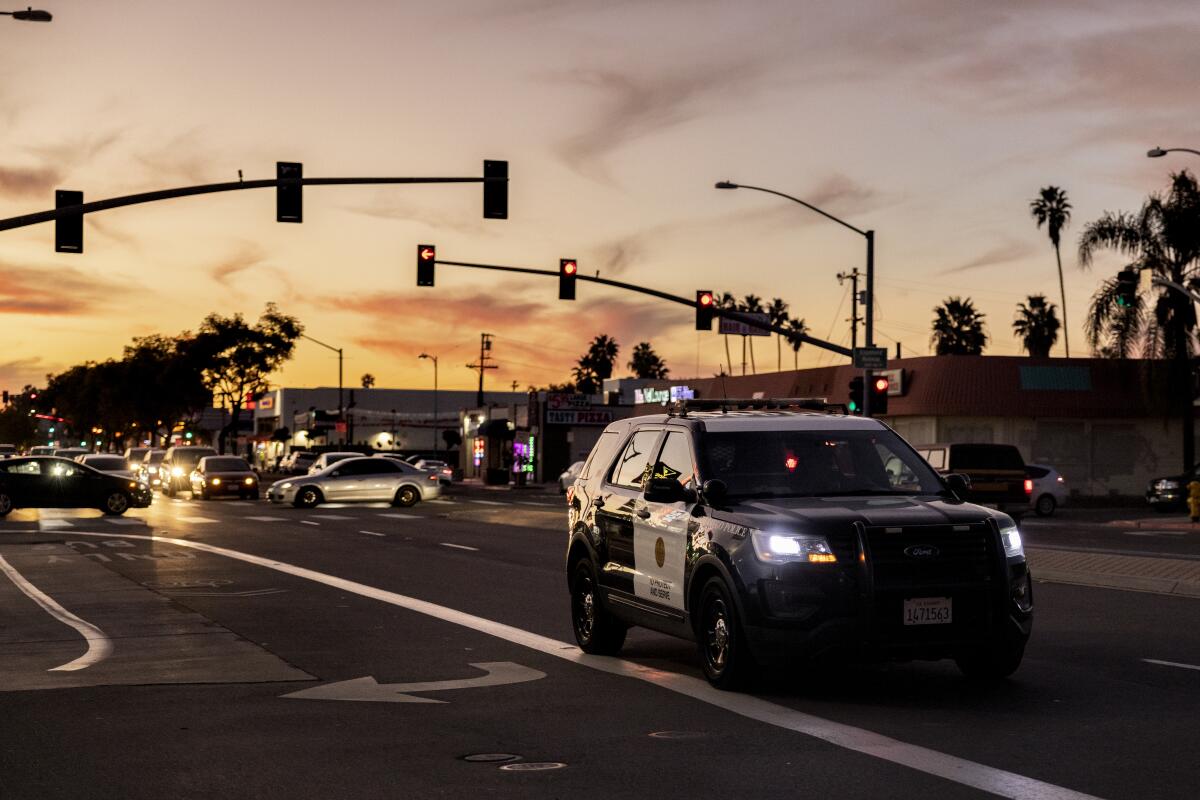Why are cops leaving the San Diego Police Department? City sees biggest exodus since 2009

- Share via
SAN DIEGO — For the first time in three years, the San Diego Police Department hosted an awards ceremony last month for officers who went beyond the call of duty.
During the event at Marine Corps Air Station Miramar, a dozen officers received the prestigious lifesaving medal for making rescues, despite the danger they faced.
Officer Daniel Clark freed a man from a burning car in 2020. That same year, Officers William Krout and Paige Haar pulled 2-year-old twin girls to safety after their father drove a pickup off Sunset Cliffs into the ocean.
This story is for subscribers
We offer subscribers exclusive access to our best journalism.
Thank you for your support.
All three officers have since left the San Diego Police Department — two in the last 4½ months. They weren’t alone.
In fiscal year 2022, which ended in July, more than 230 San Diego police officers left the department — a 52% increase compared with the previous year. It’s the highest separation total the department has seen in more than a decade, police officials say. The department has lost patrol officers and detectives, seasoned homicide investigators, collision reconstruction experts, SWAT officers, K-9 handlers, training officers and police helicopter pilots.
Most who left, 67%, didn’t retire from the department — they resigned. And nearly half of those resignations were by officers who went to other law enforcement agencies.
Haar accepted her lifesaving award in her new Carlsbad Police Department uniform.
It’s a spike police leaders knew was coming.
For months, officials with the San Diego department have warned that officers were leaving faster than they could be replaced, a phenomenon fueled by a storm of factors. Between July 2021 and early March, 168 officers had left the department. In the next three months, the department would lose another 65.
Police union leaders have blamed the city’s vaccine mandate for the steep rise in departures, but there are other reasons: staffing shortages that require overtime or constrain time off, a continuing call for changes to police practices, and jobs at other departments that offer higher pay and better retirement packages.
Lt. Adam Sharki, a department spokesperson, said some officers reported during exit interviews that the negative narrative surrounding law enforcement has left them feeling demoralized and under greater scrutiny, all while they continue to face the increasing challenges of policing in a big city.
The staffing shortages that departures often leave in their wake can have short- and long-term impacts on public safety, law enforcement leaders say. It may take officers and deputies longer to respond to emergency calls — and some minor incidents might not get responses at all.
According to annual budget reports, the San Diego Police Department responds to the most serious calls, such as shootings and stabbings, in around seven minutes. For Priority 1 calls — which include burglaries in progress, hit-and-runs and some serious felonies like child abuse and domestic violence — the wait time is nearly 40 minutes and has been climbing.
Relationships with community members and proactive policing efforts suffer as well, police leaders say.
Jared Wilson, president of the San Diego Police Officers Assn., said officers from specialty units have been pulled back to patrol so the department can keep up with 911 calls. The shortage has affected the special operations unit, which investigates violent crimes; the motor unit, which provides traffic enforcement; and the neighborhood policing division.
“We’re at the point where we’re just chasing 911 calls,” Wilson said. “We’re not really doing a whole lot of preventative policing or patrolling. It’s really toxic for our community, for community trust and relationships.”
San Diego isn’t the only local department struggling to retain sworn staff. In calendar year 2021, the San Diego County Sheriff’s Department lost 252 sworn deputies, more than half to retirements. That’s the highest total in five years. So far this year, 200 deputies have left.
The city of San Diego said in a statement that Mayor Todd Gloria had invested in a variety of initiatives designed to recruit and retain police officers, including a 10% pay raise in the most recent police contract, proposed bonuses for lateral moves from other police jurisdictions and increasing the budget for recruitment.
“With these efforts, the Mayor is confident SDPD can reach full staffing and ensure San Diego continues to be one of the safest big cities in America,” Rachel Laing, the mayor’s communications director, said in the statement.
Despite those actions, the department has struggled to fill nearly 150 open positions. Currently, the department has 2,036 budgeted positions, and about 1,890 are filled, according to staffing reports. However, of those, about 90 are academy trainees who aren’t fully sworn until they graduate and another 84 are in field training, so they aren’t certified to work on their own, Wilson said. About 140 more are on some kind of leave.
That leaves about 1,570 full-duty officers.
Wilson said the city of San Diego’s COVID-19 vaccine mandate was the breaking point for many officers, who already felt underpaid and underappreciated.
Many San Diego police officers opposed the mandate when it was announced in August, with some saying they would rather be fired than comply. Most of the police union’s members did, ultimately, get vaccinated, but 425 out of about 1,900 asked for medical or religious exemptions. City officials said 417 of those requests have been approved.
“If you make a requirement for your employees, and they’re not interested in following it for whatever reason, and their portability as an employee is very high, then you’re going to lose them,” Wilson said. “And that’s what we saw. We have lost an extraordinary number of people because of it.”
More than a quarter of the officers who left the San Diego Police Department this fiscal year went to other law enforcement agencies.
El Cajon City Manager Graham Mitchell said the department hired seven San Diego police officers in the last fiscal year. San Diego officers have also gone to police departments in Carlsbad and Oceanside, the Sheriff’s Department and the county district attorney’s office, Wilson said. Of all the departures in fiscal year 2022, nearly a quarter — more than 60 officers — left for other police agencies.
Mitchell said that he speaks with every police officer who joins El Cajon’s department and that many officers from San Diego have said they enjoy the policing experience a smaller department offers.
El Cajon also doesn’t have a vaccine mandate.
Cid Martinez, an associate professor at the University of San Diego who specializes in policing, said it’s no coincidence officers are leaving now.
After George Floyd was killed in May 2020 at the hands of Minneapolis police, protesters called for police departments across the nation to demonstrate greater accountability and transparency.
In San Diego, proposed policy packages such as the Preventing Over-policing through Equitable Community Treatment ordinance — or PrOTECT — would seriously limit when officers can stop and search people. Proponents say the changes would guard against racial profiling and strengthen accountability. Law enforcement leaders have called the package radical and contend it would seriously hamper important police work. Last year, the Public Safety and Livable Neighborhoods Committee asked the city attorney’s office for a review of the proposal, but the City Council has not formally reviewed it.
For some, that heightened level of scrutiny may be enough to prompt a career change, Martinez said. But officers who aren’t ready to turn in the badge may instead gravitate toward smaller, suburban departments where calls for accountability may be more muted.
There likely isn’t one factor that fueled the spike in departures from the San Diego Police Department, he said, not even the city’s vaccine mandate that caused such an uproar.
“If an officer feels committed and connected to their community, that’s not going to be their only consideration,” Martinez said.
More to Read
Sign up for Essential California
The most important California stories and recommendations in your inbox every morning.
You may occasionally receive promotional content from the Los Angeles Times.














